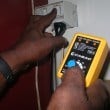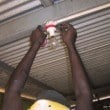A1.3 Cabling and wiring
Poorly installed, faulty or old electrical installations pose a serious risk of electrocution or electrical fire, both of which can be fatal.
Undersized electrical cabling is a common risk in old houses. Older houses may need larger electrical cables because of the increased load on the electrical circuits caused by new electrical appliances or fittings. Even in new houses, it is important that cables are large enough and the circuits have the capacity to meet the demands of the expected number of people in the house and to carry the appliance load.
Electrical cabling becomes unsafe if the bare wires are exposed and they rub or strain against structural steel framing or other rough edges. Nails, screws and household pests can also damage cabling, which can lead to electrical faults, shocks or fires. It is very important to make sure that electrical installations and fittings are isolated from household pests. Pest related problems could include:
- mice and rats gnawing the insulating cover of electrical cables and exposing bare wires
- cockroaches, mice and ants nesting and causing faults in electrical fittings
- in the tropics, local ants infesting electrical conduits, wiring, fittings and appliances
- feral animals uncovering underground cabling or disturbing the earth stake connection.
Incorrect wiring of electrical fittings is also very unsafe. Electrical safety switches and circuit breakers may not work properly if the electrical fittings are incorrectly wired, and this increases the risk of electrocution and fire. Incorrect wiring of fittings can also cause fire, and exposed household cables can pose a serious safety risk.
Survey data show a slight decrease in the number of houses with framed wall construction from 71% in 2013 to 70% in 2024. This has slightly reduced the risk of providing habitats for mice that may attack cabling. However, a large amount of houses (44%) surveyed had incandescent light fittings and mice are attracted to the warmth from incandescent globes. They may nest in the ceiling space directly above the lights and gnaw on exposed electrical cables and increase the risk of fire.
Real world examples of problems
-
 Exposed cabling at light switch. Consider carefully the location and height of switches.
Exposed cabling at light switch. Consider carefully the location and height of switches. -
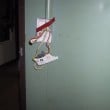 Exposed cabling at light switch. Consider carefully the location and height of switches.
Exposed cabling at light switch. Consider carefully the location and height of switches. -
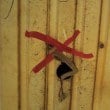 Exposed cabling
Exposed cabling -
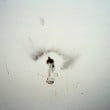 Exposed cabling at smoke detector
Exposed cabling at smoke detector -
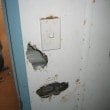 Holes in walls can expose electrical cabling
Holes in walls can expose electrical cabling -
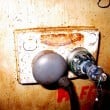 Ants can infest electrical conduits, wiring, fittings and appliances. Formic acid in an ants body can impact on electrical fittings.
Ants can infest electrical conduits, wiring, fittings and appliances. Formic acid in an ants body can impact on electrical fittings. -
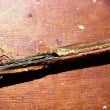 Rodent damage to cabling
Rodent damage to cabling -
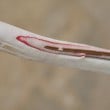 Ant damage to cabling
Ant damage to cabling -
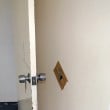 A missing doorstop can mean wall and handle damage and an easy access point into wall cavities for mice - leading to electrical faults.
A missing doorstop can mean wall and handle damage and an easy access point into wall cavities for mice - leading to electrical faults.
-
Design and Specification
Ensure
- A1.3.1.
the consumer mains are inside a pipe or ‘conduit’ that runs from the ground connection point to the main safety switch
- A1.3.2.
external cabling is laid at least 600mm underground to prevent accidental damage
- A1.3.3.
electrical cables are protected and isolated from steel or metal framing
- A1.3.4.
all cable is run vertically, not horizontally, in walls
- A1.3.5.
where cables cannot be placed in the wall they are in a conduit
- A1.3.6.
wall frames are strengthened eg extra noggins or studs where electrical fittings are located
- A1.3.7.
household pests have no way to enter or infest the house; see B6 ‘Reducing the negative effects of animals, insects and vermin’
- A1.3.8.
penetrations through bond beams, slabs and walls for electrical wiring are mechanically sealed against vermin entry – (some silicon sealants can contain vermin proof compounds but mechanical barriers to vermin entry are preferred)
- A1.3.9.
doorstops are fixed to the structure behind wall linings, NOT surface mounted, to be effective in preventing damage to walls
Consider
- checking cable sizes, and upgrading the cables where necessary
- using stranded cable instead of single wire
- protecting all cables from pest damage by enclosing them in conduit
- providing surge protection.
Real world examples of Solutions
- A1.3.1.
Quality control
- any externally fitted cables are located inside a conduit.

- COMPLETED DESIGN & SPECIFICATION
DURING CONSTRUCTION
AT HANDOVER
FINAL COMPLETION
- COMPLETED DESIGN & SPECIFICATION
- all electrical circuits are sized for load capacity

- AT HANDOVER
FINAL COMPLETION
TRADE TEST
- AT HANDOVER
- adequacy of cable sizes

- AT HANDOVER
FINAL COMPLETION
TRADE TEST
- AT HANDOVER
- the location and installation of all power points, lights, fans and other fittings.

- COMPLETED DESIGN & SPECIFICATION
DURING CONSTRUCTION
AT HANDOVER
TRADE TEST
- COMPLETED DESIGN & SPECIFICATION
- any externally fitted cables are located inside a conduit.
Maintenance
As part of cyclical maintenance:
- check that the power points are safe, using a power point tester (available from electrical and major hardware stores)

- Local Maintenance Team, Housing Management
- 12 Months
- check that all lights, switches, fans and other fittings are operating, have no exposed wiring and are not cracked or loose

- Local Maintenance Team, Housing Management
- 12 Months
- install or replace door stops to avoid wall damage and mice entry

- Local Maintenance Team, Housing Management
- 12 Months
- as a high priority, patch holes in walls and ceilings where cabling is exposed.

- Carpenter, Local Maintenance Team, Housing Management
- 6 Months
- where houses are exposed to high levels of known household pests (mice plagues, ants etc), engage an electrician to regularly load test houses to ensure that electrical cables and fittings are safe.

- Electrician, Housing Management
- 12 Months
- always use a licensed electrician to carry out electrical maintenance work, and to install electrical equipment such as lights, power points, switches, stoves, hot water systems and electrical pumps.

- Electrician
- 12 Months
- where stoves, hot water systems and electrical pumps are not hard wired, (a cable from the appliance to the switchboard without a plug and socket), these appliances may not require an electrician to carry out replacement.

- Local Maintenance Team, Housing Management
- 24 Months
- check that the power points are safe, using a power point tester (available from electrical and major hardware stores)
Standard And References
AS/NZS 3000:2018 - Electrical installations (known as the Australian/New Zealand Wiring Rules)

